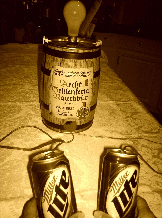
Minutus cantorum, minutus balorum, minutus carborata descendum pantorum
The Benevolent Order of Zymurology is as ancient as time itself with its beginnings lost to antiquity, although the tenets of our faith have been honed through the ages. While some may claim our Order is too firmly entrenched in the past we do embrace technology and any advancement that might further the cause is most welcome.


HISTORY
The immaculate beverage known to laypeople simply as beer is one of the world's oldest dating back to the 6th millennium BC before the advent of writing, credited to the Sumerian's which referenced the most divine of beverages and offered prayers to the goddess Ninkasi. "The Hymn to Ninkasi" served as both a prayer as well as a method of remembering the recipe. Archeological evidence of the creation of beer is over 5,000 years old from the site of Godin Tepe in the Zagros Mountains of western Iran. As several noted scholars through the ages such as Frank Zappa noted, the invention of bread and beer was likely responsible for humanity's ability to develop technology and build civilizations. Although much of the world developed as male dominated societies it is worth remembering women produced most beer until the middle ages. By the 7th century AD beer was increasingly being produced and sold by European monasteries inhabited by monks that delved into the rudimentary scientific methods of the time to improve their craft. During the Industrial Revolution, much of the production of beer in countries such as England and the United States moved from artisanal to industrial production.
Zymurgy
A branch of chemistry which deals
with
wine-making and brewing, 1868, from Gk. zymo-, comb. form of zyme "a
leaven" (from PIE base *yus-; see juice) + -ourgia "a working," from
ergon "work" (see urge (v.)). The last word in many standard English
dictionaries; but in the OED [2nd ed.] the last word is zyxt, an
obsolete Kentish form of the second person singular of see (v.).
Ology
Informally, an ology is a field of study or academic discipline ending in the suffix -ology.The word ology is a back-formation from the names of these disciplines. Such words are formed from Greek or Latin roots with the terminal -logy derived from the Greek suffix -λογια (-logia), speaking, from λεγειν (legein), to speak.
Salvation is within reach